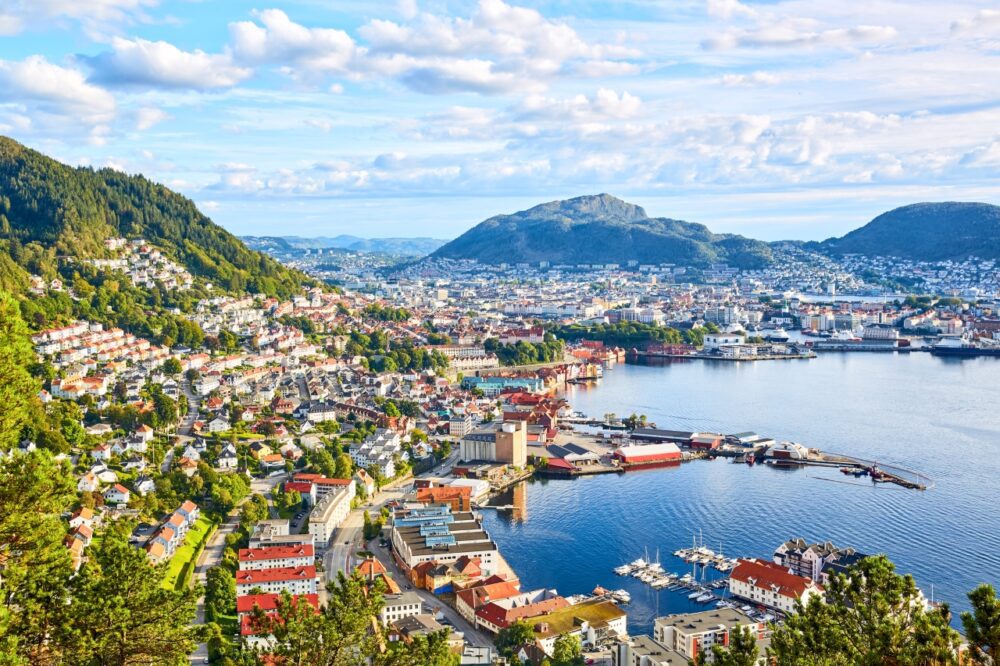
Is Bergen worth visiting? Without a doubt! The first time I arrived in Bergen, I was blown away by its postcard-perfect scenery. Nestled between seven mountains and surrounded by stunning fjords, Bergen feels like it was plucked straight out of a fairytale. Wandering through the colourful wooden houses of Bryggen, exploring the bustling fish market, and taking in the panoramic views from Mount Fløyen made it clear why Bergen is called the “Gateway to the Fjords.”
Located on Norway’s west coast, Bergen is a city that’s as charming as it is dramatic. It’s best known for its historic Hanseatic Wharf, a UNESCO World Heritage Site, and its role as the jumping-off point for fjord cruises. But beyond the fjords, Bergen is a cultural hub with a vibrant arts scene, cosy cafés, and a relaxed, friendly vibe. Whether you’re exploring the city’s narrow alleyways, hiking one of its surrounding mountains, or embarking on an epic fjord adventure, Bergen offers an experience that’s both serene and unforgettable.
But is Bergen worth visiting for you? In this blog post, we’ll uncover the top 10 reasons why Bergen should be on your travel list, from its breathtaking landscapes to its rich cultural history. Plus, we’ll share travel tips to help you make the most of your time in this Norwegian gem. Keep reading to discover why Bergen might just steal your heart.
Table of Contents
Pros – Reasons You Should Visit Bergen
1. A Stunning Coastal Location Surrounded by Fjords and Mountains
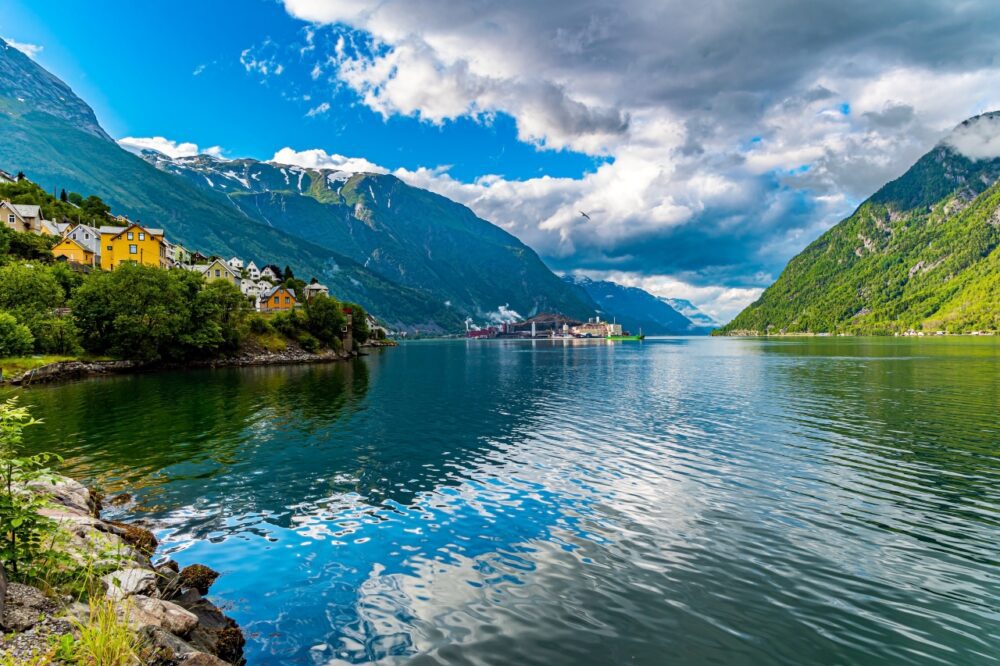
Bergen is often called the “Gateway to the Fjords,” and its breathtaking natural surroundings make it one of the most scenic cities in Norway. Nestled between seven mountains and the North Sea, it offers stunning views no matter where you look. The combination of deep blue waters, rugged peaks, and colorful wooden houses gives Bergen a charm that feels both peaceful and dramatic.
I took a boat trip through the nearby fjords, and the experience was unforgettable. Towering cliffs, cascading waterfalls, and serene waterways made it feel like I was sailing through a postcard. Even within the city itself, there are countless places where you can take in the scenery, from the waterfront promenade to the many hiking trails overlooking the town.
2. The UNESCO-Listed Bryggen Wharf is Like Stepping Back in Time
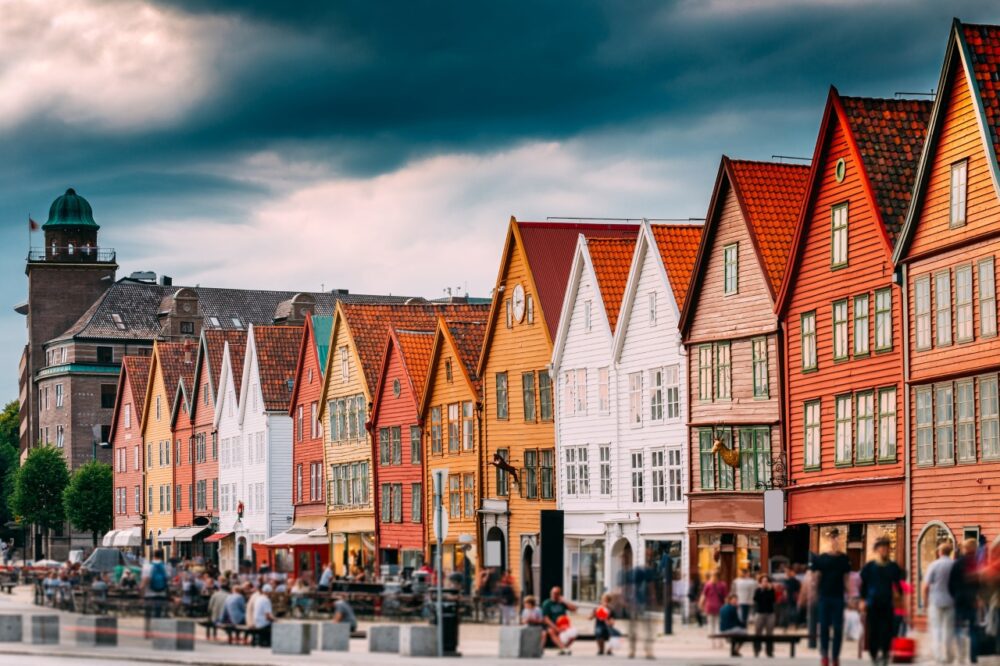
Bryggen, Bergen’s historic waterfront, is one of Norway’s most famous sights. This UNESCO World Heritage site is a row of colorful wooden buildings that date back to the Hanseatic trading era, when Bergen was one of the most important ports in Northern Europe.
Walking through the narrow alleyways behind the wooden facades, I felt like I had traveled back in time. The creaky floors, exposed beams, and tiny artisan shops made it easy to imagine what life was like when merchants used to trade fish and goods here. It’s not just a tourist attraction—it’s a living piece of history that gives Bergen a unique character.
3. Incredible Fjord Cruises and Day Trips
Bergen is the perfect base for exploring Norway’s famous fjords, with easy access to some of the country’s most spectacular landscapes. Popular fjords like Nærøyfjord, Sognefjord, and Hardangerfjord are all within reach, offering a chance to experience Norway’s dramatic nature up close.
I took a cruise through Nærøyfjord, and the sheer cliffs, mirror-like waters, and tiny villages along the shore made it one of the most beautiful places I’ve ever seen. Whether you opt for a short boat trip or a full-day fjord excursion, seeing these landscapes from the water is a must when visiting Bergen.
4. The Fløibanen Funicular Offers One of the Best Views in Norway
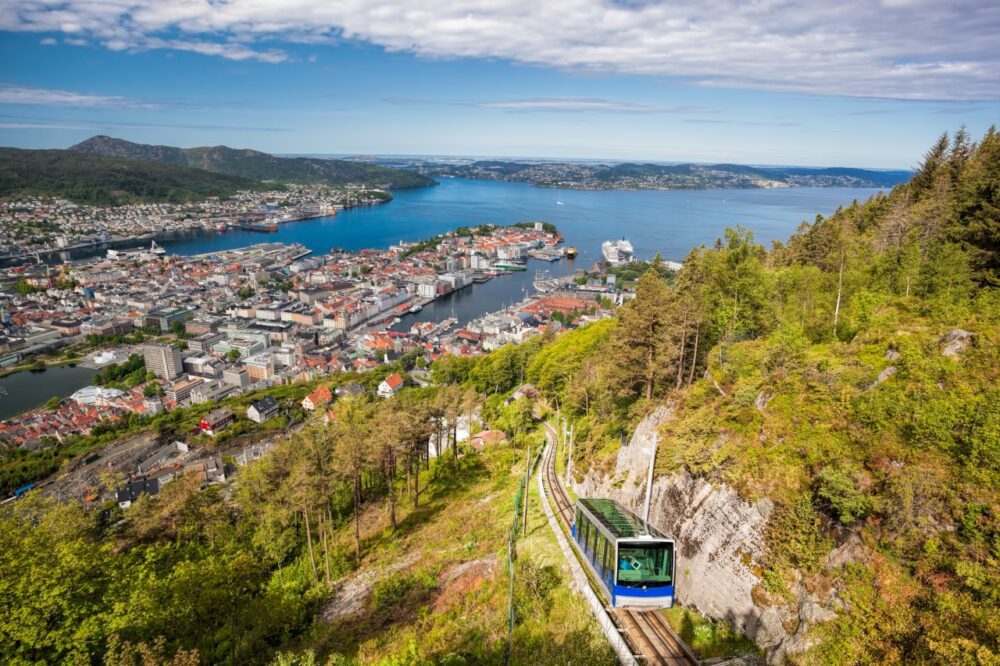
For an easy and spectacular panoramic view of Bergen, the Fløibanen funicular takes you to the top of Mount Fløyen in just a few minutes. From the summit, you can see the entire city, the fjords, and the surrounding mountains stretching into the distance.
I went up in the late afternoon and was blown away by the view. Watching the sunset from the top, with the city lights flickering below, was one of the highlights of my trip. There are also hiking trails and a café at the top, making it a great place to spend some time soaking in the scenery.
5. Bergen’s Seafood Scene is One of the Best in Scandinavia
Bergen has long been a center for Norway’s fishing industry, and its seafood is among the freshest you’ll find anywhere. The city’s fish market, located right on the waterfront, is the perfect place to sample local specialties like smoked salmon, king crab, and the famous Bergen fish soup.
I tried rakfisk (fermented fish) and was pleasantly surprised by its rich, deep flavor. Another standout dish was klippfisk, or dried and salted cod, which has been a staple of Norwegian cuisine for centuries. Whether you grab a quick meal at the market or dine at one of the city’s excellent seafood restaurants, Bergen is a paradise for seafood lovers.
6. A Gateway to Some of Norway’s Best Hiking Trails
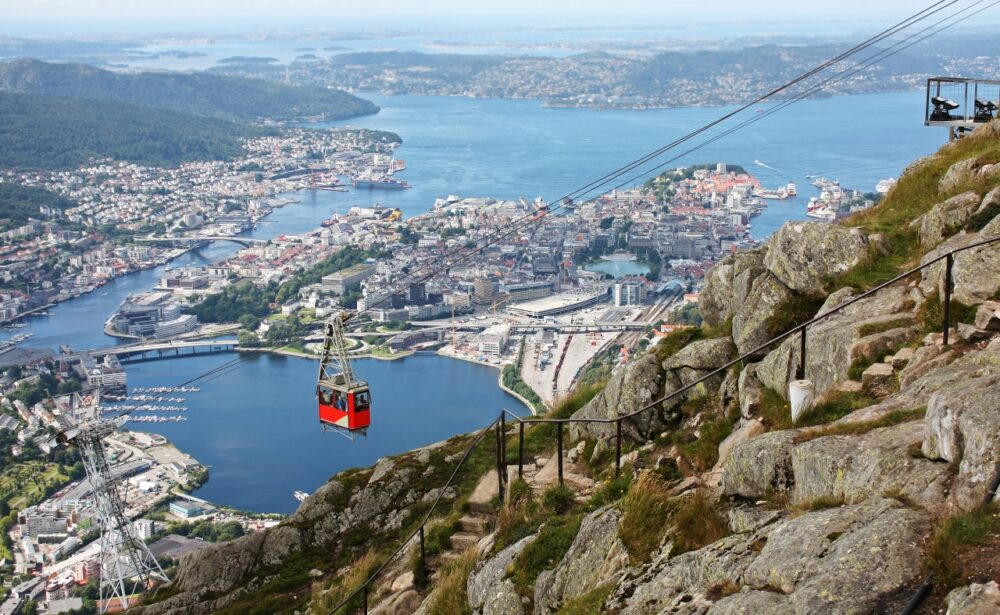
Bergen is surrounded by stunning hiking trails that cater to all levels of hikers. Whether you’re looking for an easy walk with a great view or a challenging trek through rugged terrain, there’s a trail for you.
I hiked to the top of Mount Ulriken, the highest of Bergen’s seven mountains, and the view was absolutely breathtaking. The trail was steep at times, but the sight of the fjords and islands stretching out below made every step worth it. For those who prefer a less strenuous option, Mount Fløyen has gentler trails that are just as scenic.
7. The City’s Small Size Makes it Easy to Explore on Foot
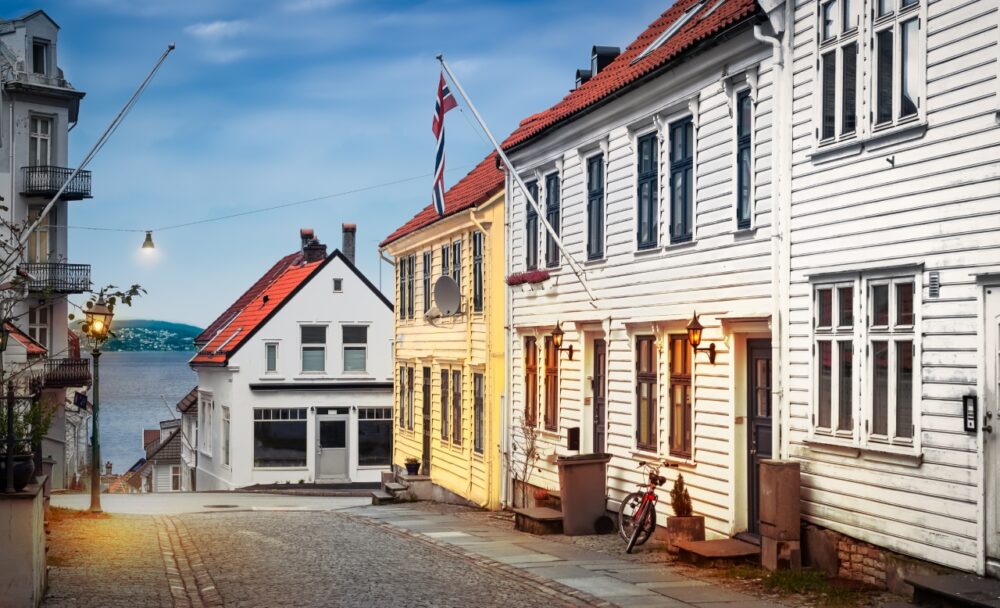
Unlike larger cities, Bergen has a compact city center that makes it easy to explore without needing public transport. Most of the main attractions, including Bryggen, the fish market, and the funicular, are all within walking distance of each other.
I loved being able to wander through the cobbled streets at my own pace, stumbling upon hidden alleys, small cafés, and charming old houses. The city’s relaxed, pedestrian-friendly layout makes it an ideal place for slow, enjoyable sightseeing.
8. A Rich Viking and Hanseatic History
Bergen has a fascinating history that goes beyond just its stunning landscapes. From its Viking origins to its time as a Hanseatic trading hub, the city has played an important role in shaping Norway’s identity.
I visited the Hanseatic Museum, which provided an incredible insight into the lives of the German merchants who controlled Bergen’s trade in the Middle Ages. The medieval artifacts, reconstructed trading offices, and stories of the people who lived here brought the city’s past to life in a way that was both engaging and educational.
9. A Cozy and Atmospheric City, Even in the Rain
Bergen is known for being one of the rainiest cities in Europe, but instead of ruining the experience, the misty weather adds to the city’s charm. The wet cobblestone streets, fog-covered mountains, and cozy cafés create an atmosphere that feels warm and inviting, even when it’s drizzling outside.
I spent a rainy afternoon tucked away in a small café, sipping hot chocolate and watching the raindrops slide down the window. The soft glow of lanterns and the smell of fresh pastries made it a perfect escape from the wet weather. Bergen has a way of making rainy days feel magical rather than miserable.
10. Bergen’s Festivals and Cultural Scene Bring the City to Life
Despite its small size, Bergen has a thriving arts and cultural scene, with festivals, concerts, and exhibitions happening year-round. The Bergen International Festival, held every summer, brings together music, theater, and dance performances from around the world.
I was lucky enough to catch a classical concert in the historic Grieghallen, a venue named after Norway’s most famous composer, Edvard Grieg. The city also has a vibrant street art scene, with colorful murals and creative installations adding a modern touch to its historic streets. Whether you’re interested in music, literature, or art, Bergen has something to offer.
Cons – Things to Consider When Visiting Bergen
1. Bergen is One of the Rainiest Cities in Europe
Bergen’s biggest drawback is its weather. The city experiences rain for an average of 200 days a year, meaning that no matter when you visit, you’re likely to encounter at least a few wet days. While the misty atmosphere can make the city feel cozy and romantic, constant drizzle or heavy downpours can make sightseeing less enjoyable.
I arrived in Bergen expecting a little rain but was surprised at how frequently the showers came and went. One moment, the sky was bright, and the next, I was running for cover under a shop awning as a sudden downpour soaked the streets. Even with waterproof clothing, walking around in the rain all day can be tiring. If you visit Bergen, packing a rain jacket, waterproof shoes, and an umbrella is absolutely essential.
2. Norway is Expensive, and Bergen is No Exception
Norway is known for being one of the most expensive countries in the world, and Bergen is no exception. Accommodation, dining, and attractions all come with high price tags, which can make visiting the city challenging for budget travelers. Even basic meals and transport can add up quickly, making it difficult to explore the city affordably.
I was shocked when I bought a simple sandwich and coffee at a café near Bryggen and realized it had cost me nearly the same as a full meal in other European cities. Eating out regularly can be expensive, and even supermarket prices are noticeably higher than in other countries. While there are ways to save—such as cooking in an Airbnb or looking for budget-friendly bakeries—visitors should be prepared for high costs when planning a trip to Bergen.
3. The City Can Feel Small if You Stay Too Long
Bergen is charming and full of history, but it is not a huge city, and for travelers who plan to stay more than a few days, it can start to feel a bit small. Most of the major attractions, such as Bryggen, Mount Fløyen, and the fish market, can be explored within a couple of days, meaning that after that, you may need to take day trips to keep things interesting.
I spent four days in Bergen, and by the third day, I felt like I had already seen most of what the city itself had to offer. Fortunately, there are plenty of excursions to the fjords, surrounding villages, and hiking trails to fill up extra time. However, if you’re looking for a destination with endless attractions and activities, Bergen might not be the best place for a long stay.
4. The Weather Can Change Quickly, Making Outdoor Plans Unpredictable
Even if it’s not raining, Bergen’s weather is highly unpredictable. You can start the day with blue skies, only for clouds and mist to roll in suddenly, changing the entire feel of the city. This can make planning outdoor activities—such as fjord cruises or hikes—difficult, as the conditions may not be as expected when you arrive.
I had planned to hike up Mount Ulriken, but halfway through the climb, thick fog covered the entire landscape, blocking all the views I had hoped to see. Another time, I booked a fjord tour on what was supposed to be a clear day, only for unexpected rain and wind to make the boat ride much less enjoyable. While Bergen’s natural beauty is spectacular, visitors should be prepared for sudden weather changes that can impact their plans.
5. Tourist Crowds Can Be Heavy in Peak Season
While Bergen is smaller than Oslo, it is one of Norway’s most visited cities, particularly in the summer when fjord cruises and outdoor activities attract thousands of visitors. During the peak months, areas like Bryggen, the fish market, and the funicular to Mount Fløyen can become quite crowded, making it harder to fully enjoy the city’s charm.
I visited Bergen in July, and while the city never felt overwhelmingly packed, the line for the Fløibanen funicular was much longer than expected, and getting a good photo in Bryggen without tourists in the background was nearly impossible. Restaurants and cafés were often full, requiring reservations in advance. If you prefer a quieter experience, visiting in the shoulder seasons—spring or early autumn—can help you avoid the biggest crowds while still enjoying everything Bergen has to offer.
When to Visit Bergen
The best times to visit Bergen are late spring (May to June) and summer (July to August), when the weather is relatively mild, and the city is alive with outdoor activities and festivals like the Bergen International Festival. Summer offers long daylight hours perfect for exploring the fjords and nearby hiking trails. Autumn (September to October) is quieter, with vibrant fall foliage adding a magical touch to the scenery. Winters in Bergen are cool and wet but atmospheric, with cosy cafes and festive markets creating a welcoming vibe.
How to Get to Bergen
Bergen Airport (BGO), located about 20 kilometres from the city centre, offers domestic and international flights via airlines like SAS, Norwegian Air, and KLM. From the airport, the Bybanen light rail provides an affordable and convenient connection to the city in about 45 minutes, while taxis are faster but more expensive. Bergen is also accessible by train, with the scenic Bergen Line connecting it to Oslo in around seven hours. For those arriving by sea, Hurtigruten coastal ferries and express boats link Bergen to other Norwegian towns and fjords.
Where to Stay in Bergen
Bergen offers a range of accommodation options catering to all budgets and preferences:
- Luxury: Bryggen Wharf – Stay near the iconic UNESCO-listed harbour. Options like Hotel Norge by Scandic or Clarion Hotel Admiral combine luxury with stunning views.
- Mid-range: City Centre – Close to attractions like the fish market and Mount Fløyen. Consider Zander K Hotel or Scandic Ørnen, which offer comfort and style at reasonable prices.
- Budget: Sandviken or Møhlenpris – These quieter areas have affordable options like Marken Guesthouse or Citybox Bergen, ideal for budget-conscious travellers.
Getting Around Bergen
Bergen is compact and easy to navigate on foot, especially in the city centre and around Bryggen Wharf. For longer distances, the Skyss public transport network, which includes buses and the Bybanen light rail, is efficient and affordable, with day passes available. Cycling is a great way to explore during the warmer months, with bike rentals and dedicated paths connecting key areas. For a unique experience, take the Fløibanen funicular to Mount Fløyen for panoramic views and hiking trails. Boat tours are also a popular way to explore the surrounding fjords and islands.
How Long to Spend in Bergen
Two to three days is perfect for enjoying Bergen’s highlights, including the Bryggen Wharf, the Fløibanen funicular, and the lively fish market. This timeframe allows time to visit the Edvard Grieg Museum or take a boat trip into the nearby fjords, such as the Hardangerfjord or Sognefjord. With an extra day, consider hiking on Mount Ulriken or exploring the picturesque island of Lysekloster. Bergen’s mix of stunning natural beauty, rich history, and vibrant culture makes it an essential stop on any Norwegian adventure.
Conclusion
So, is Bergen worth visiting? Absolutely! With its stunning fjord views, historic charm, and access to incredible outdoor adventures, Bergen is a must-visit in Norway. Highlights like the colourful Bryggen Wharf, Mount Fløyen, and the breathtaking fjords make it a truly unique destination. While it can be rainy at times, the beauty of the city and its surroundings more than make up for it. If you’re ready to experience Norway’s coastal magic, start planning your trip to Bergen today—you won’t regret it!
